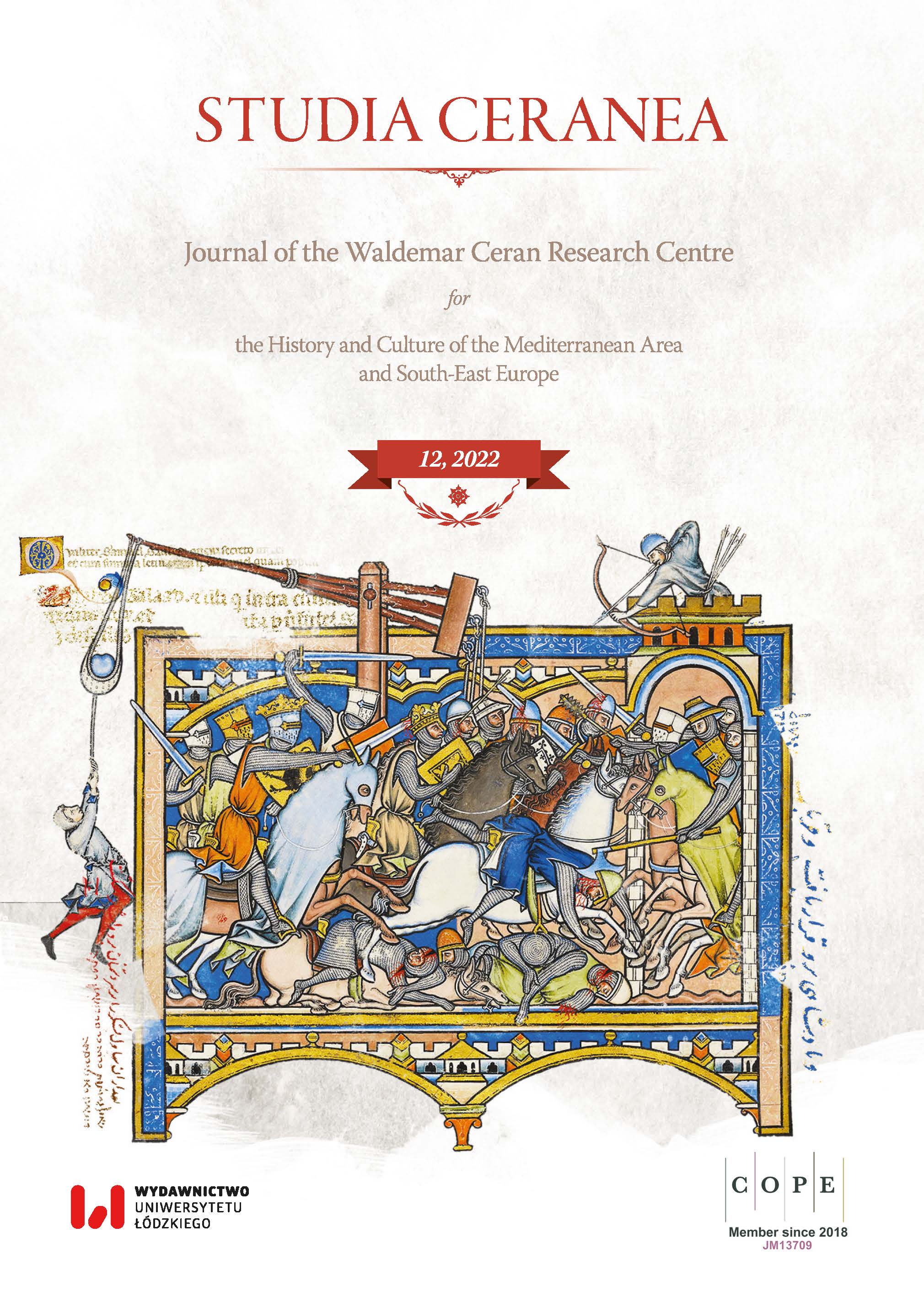The Portrayal of Abbasid Rulers in Chronography of Theophanes the Confessor
DOI:
https://doi.org/10.18778/2084-140X.12.03Keywords:
Abbasid, Byzantine historiography, Theophanes the Confessor, Byzantine-Arabic relations, CaliphateAbstract
This text supplements another, a paper presented a decade ago on the portrayal of Umayyad rulers in Chronography of Theophanes the Confessor (B. Cecota, Islam, the Arabs and Umayyad Rulers according to Theophanes the Confessor’s Chronography, “Studia Ceranea” 2, 2012, p. 97–111). I am limiting myself here to discussing only those source remarks which directly concern one of the Abbasid Caliphs, or alternatively, to narratives structured in such a manner that they implied certain traits of a ruler. General remarks concerning the portrayal of the entire dynasty have been included, both in the main text and in the footnotes, only where this was necessary for the understanding of the context in which the Caliphs’ descriptions appear.
Downloads
References
Agapius (Mahboub) de Menbidj, Kitab al-‘Unvan. Histoire universelle. Seconde Partie II, ed. et trans. A. Vasiliev, Paris 1912 [= Patrologia Orientalis, 8].
Google Scholar
Chronicon Anonymi Auctoris ad Annum Christi 1234 Pertinens, ed. I. A. Barsoum, J.-B. Chabot, Louvain 1920.
Google Scholar
Tabari, Annales, vol. I–XV, ed. M. J. de Goeje, Leiden 1879–1901.
Google Scholar
Theophanis Chronographia, еd. C. G. de Boor, Lipsiae 1883.
Google Scholar
Blankinship Kh.Y., The Tribal Factor in the Abbasid Revolution: The Betrayal of the Imam Ibrahim B. Muhammad, “Journal of the American Oriental Society” 108.4, 1988, p. 589–603, https://doi.org/10.2307/603147
Google Scholar
DOI: https://doi.org/10.2307/603147
Borrut A., Entre mémoire et pouvoir. L’espace syrien sous les derniers Omeyyades et les premiers Abbassides (v. 72–193/692–809), Leiden–Boston 2011 [= Islamic History and Civilization, 81], https://doi.org/10.1163/ej.9789004185616.i-544
Google Scholar
DOI: https://doi.org/10.1163/ej.9789004185616.i-544
Cecota B., Islam, the Arabs and Umayyad Rulers according to Theophanes the Confessor’s Chronography, “Studia Ceranea” 2, 2012, p. 97–111, https://doi.org/10.18778/2084-140X.02.09
Google Scholar
DOI: https://doi.org/10.18778/2084-140X.02.09
Cobb P. M., Community versus Contention: Ibn ‘Asākir and ‘Abbāsid Syria, [in:] Ibn ‘Asākir and Early Islamic History, ed. J. E. Lindsays, Princeton 2001, p. 100–126, https://doi.org/10.2307/j.ctv1b9f5s7.10
Google Scholar
DOI: https://doi.org/10.2307/j.ctv1b9f5s7.10
Cobb P. M., White Banners. Contention in ‘Abbasid Syria, 750–880, Albany NJ 2001.
Google Scholar
Crone P., Medieval Islamic Political Thought, Edinburgh 2005, https://doi.org/10.1515/9780748646500
Google Scholar
DOI: https://doi.org/10.1515/9780748646500
Crone P., Were the Qays and Yemen of the Umayyad Period Political Parties?, “Der Islam” 71, 1994, p. 1–57, https://doi.org/10.1515/islm.1994.71.1.1
Google Scholar
DOI: https://doi.org/10.1515/islm.1994.71.1.1
Daniel E. L., The Anonymous “History of the Abbasid Family” and its Place in Islamic Historiography, “International Journal of Middle East Studies” 14.4, 1982, p. 419–434, https://doi.org/10.1017/S0020743800052144
Google Scholar
DOI: https://doi.org/10.1017/S0020743800052144
Demichelis M., Between Mu‘tazilism and Syncretism: A Reappraisal of the Behavior of the Caliphate of al-Ma’mūn, “Journal of Near Eastern Studies” 71.2, 2012, p. 257–274, https://doi.org/10.1086/666733
Google Scholar
DOI: https://doi.org/10.1086/666733
Figueroa M. R., Religión y Estado durante la dinastía abasí. El califato de al-Mansur, “Estudios de Asia y Africa” 40.1, 2005, p. 57–87.
Google Scholar
Hoexter M., The Role of the Qays and Yaman Factions in Local Political Divisions. Jabal Nablus Compared with the Judean Hills in the First Half of the Nineteenth Century, “Asian and African Studies” 2.1, 1972, p. 277–282.
Google Scholar
Kaabi M., Les origines ṭāhirides dans la da‘wa ‘abbāside, “Arabica” 19.2, 1972, p. 145–164, https://doi.org/10.1163/157005872X00249
Google Scholar
DOI: https://doi.org/10.1163/157005872X00249
Kennedy H., The Origins of the Qays-Yaman Dispute in Bilad al-Sham, [in:] Proceedings of the Second Symposium on the History of Bilād al-Ṣḥam during the Early Islamic Period up to 40 A. H. / 640 A. D. The Fourth International Conference on the History of Bilad al-Sham, ed. M. A. Bakhit, Amman 1987, p. 168–174.
Google Scholar
Lassner J., The Shaping of ‘Abbasid Rule, Princeton 1980 [= Princeton Studies on the Near East, 5102], https://doi.org/10.1515/9781400886364
Google Scholar
DOI: https://doi.org/10.1515/9781400886364
Marsham A., Rituals of Islamic Monarchy. Accession and Succession in the First Muslim Empire, Edinburgh 2009, https://doi.org/10.1515/9780748630776
Google Scholar
DOI: https://doi.org/10.1515/9780748630776
Marsham A., Robinson C. F., The Safe-Conduct for the Abbasid ‘Abd Allāh b. ‘Alī (d. 764), “Bulletin of the School of Oriental and African Studies” 70.2, 2007, p. 247–281, https://doi.org/10.1017/S0041977X07000420
Google Scholar
DOI: https://doi.org/10.1017/S0041977X07000420
Mutter J. S., By the Book: Conversion and Religious Identity in Early Islamic Bilād al-Shām and al-Jazīra (PhD Thesis, The University of Chicago 2018).
Google Scholar
Nawas J. A., All in the Family? Al-Mu‘taṣim’s Succession to the Caliphate as Denouement to the Lifelong Feud between al-Ma’mūn and his ‘Abbasid Family, “Oriens” 38, 2010, p. 77–88, https://doi.org/10.1163/187783710X536662
Google Scholar
DOI: https://doi.org/10.1163/187783710X536662
Nawas J. A., Al-Ma‘mun, the Inquisition, and the Quest for Caliphal Authority, Lockwood 2015, https://doi.org/10.5913/2015550
Google Scholar
DOI: https://doi.org/10.5913/2015550
Omar F., Some Aspects of the ‘Abbāsid-Ḥusaynid Relations during the Early ‘Abbāsid Period 132–193 A. H./750–809 A. D., “Arabica” 22.2, 1975, p. 170–179, https://doi.org/10.1163/157005875X00570
Google Scholar
DOI: https://doi.org/10.1163/157005875X00570
Omar F., The ‘Abbasid Caliphate, 132/750–170/786, Baghdad 1969.
Google Scholar
Rihan M., The Politics and Culture of An Umayyad Tribe. Conflict and Factionalism in the Early Islamic Period, London–New York 2014 [= Library of Middle East History, 41], https://doi.org/10.5040/9780755608317
Google Scholar
DOI: https://doi.org/10.5040/9780755608317
Roberts A. M., Al-Mansūr and the Critical Ambassador, “Bulletin d’études orientales” 60, 2011, p. 145–160, https://doi.org/10.4000/beo.406
Google Scholar
DOI: https://doi.org/10.4000/beo.406
Rudnicka-Kassem D., Realizing an Insightful Vision of a Powerful and Independent State. Ahmad ibn Tulun and the Reign of his Dynasty (868–905), “Krakowskie Studia Międzynarodowe” 11.3, 2014, p. 11–23.
Google Scholar
Shaban M. A., The ‘Abbasid Revolution, Cambridge 1970.
Google Scholar
Sharon M., Black Banners from the East. The Establishment of the ‘Abbāsid State. Incubation of a Revolt, Jerusalem–Leiden 1983.
Google Scholar
Vloten van G., Recherches sur la domination arabe, le Chiitisme et les croyances messianiques sous le Khalifat des Omayades, Amsterdam 1894.
Google Scholar
Vloten van G., Zur Abbasidengeschichte, “Zeitschrift der Deutschen Morgenländischen Gesellschaft” 52, 1898, p. 218–226.
Google Scholar
Wellhausen J., Das arabische Reich und sein Sturz, Berlin 1960, https://doi.org/10.1515/9783110821529
Google Scholar
DOI: https://doi.org/10.1515/9783110821529
Yücesoy H., Messianic Beliefs and Imperial Politics in Medieval Islam. The ‘Abbāsids Caliphate in the Early Ninth Century, Columbia SC 2009.
Google Scholar
Downloads
Published
How to Cite
Issue
Section
License

This work is licensed under a Creative Commons Attribution-NonCommercial-NoDerivatives 4.0 International License.














